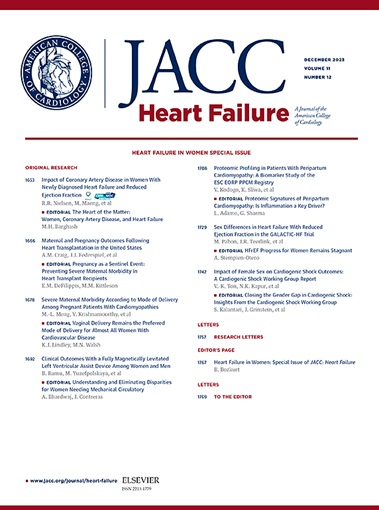有症状的心力衰竭患者可插入心脏监护仪识别心律失常的发生率
IF 10.3
1区 医学
Q1 CARDIAC & CARDIOVASCULAR SYSTEMS
引用次数: 0
摘要
慢性心力衰竭(CHF)患者的慢速心律失常和快速心律失常与发病率和死亡率增加相关。可插入心脏监测器为不适合心脏植入式电子设备的CHF患者提供了连续、动态、准确的监测策略。目的:本研究旨在评估在射血分数(EF)谱上没有心脏植入式电子装置适应症的CHF患者心律失常(CAs)的发生情况。方法在LINQ- hf(揭示LINQ心力衰竭)和1期缓解- hf(使用LINQ传感器评估和治疗心力衰竭的算法)研究中,近期发生心力衰竭事件的患者植入可插入式心脏监护仪。所有ca首先使用人工智能模型进行判定,然后人工验证,并分为3类:心房颤动(AF)、室性心动过速(VT)或颤动(VF)和心动过缓/暂停。结果163例患者(平均年龄67.2±11.2岁,男性62.6%,EF≥50% 49.1%,III级83.4%,AF病史55.2%)随访17.2±9.8个月。2年时房颤发生率为59.7%,射血分数降低(HFrEF)≥50%的心力衰竭发生率为53.1%,射血分数≥50%的心力衰竭发生率为64.6%。无房颤患者的房颤发生率为23.8%,HFrEF组为23.9%,HFpEF组为27.6%。心动过缓或停搏的发生率为37.2%,其中HFrEF为37.5%,HFpEF为39.8%;白天30.3%,夜间19.4%)。VT/VF的发生率为14.3%,HFrEF为19.8%,HFpEF为10.4%。结论在接受动态、连续、准确心律失常监测的CHF患者中,HFpEF与HFrEF患者房颤和心动过缓/暂停事件的发生率高且相似。HFpEF组VT/VF低于HFrEF组,但具有重要的临床意义。本文章由计算机程序翻译,如有差异,请以英文原文为准。
Incidence of Cardiac Arrhythmias Identified by Insertable Cardiac Monitors in Patients With Symptomatic Heart Failure
Background
Cardiac bradyarrhythmias and tachyarrhythmias in chronic heart failure (CHF) patients are associated with increased morbidity and mortality. Insertable cardiac monitors provide a continuous, ambulatory, accurate monitoring strategy for patients with CHF who are not candidates for cardiac implantable electronic devices.
Objectives
This study aims to assess the occurrence of cardiac arrhythmias (CAs) in patients with CHF across the ejection fraction (EF) spectrum and not indicated for cardiac implantable electronic devices.
Methods
Patients with recent heart failure events enrolled in LINQ-HF (Reveal LINQ Heart Failure) and Phase 1 ALLEVIATE-HF (Algorithm Using LINQ Sensors for Evaluation and Treatment of Heart Failure) studies were implanted with an insertable cardiac monitor. All CAs were adjudicated first using an artificial intelligence model, then manually verified, and grouped into 3 categories: atrial fibrillation (AF), ventricular tachycardia (VT) or fibrillation (VF), and bradycardia/pauses.
Results
In total, 163 patients (mean age 67.2 ± 11.2 years, 62.6% male, 49.1% EF ≥50%, 83.4% Class III, 55.2% history of AF) were followed for 17.2 ± 9.8 months. Occurrence of AF was 59.7% at 2 years, 53.1% in heart failure with reduced ejection fraction (HFrEF) <50%, and 64.6% in heart failure with preserved ejection fraction (HFpEF) ≥50%. Incidence of AF in patients without prior AF was 23.8%, 23.9% in HFrEF, and 27.6% in HFpEF. Incidence of bradycardia or pause was 37.2% overall, (37.5% in HFrEF and 39.8% in HFpEF; 30.3% during daytime vs 19.4% during nighttime). Incidence of VT/VF was 14.3% overall, 19.8% in HFrEF, and 10.4%, in HFpEF.
Conclusions
In CHF patients undergoing ambulatory, continuous, accurate arrhythmia monitoring, the incidence of AF and bradycardia/pause events was high and similar in HFpEF vs HFrEF patients. VT/VF was lower in HFpEF than HFrEF, but clinically important.
求助全文
通过发布文献求助,成功后即可免费获取论文全文。
去求助
来源期刊

JACC. Heart failure
CARDIAC & CARDIOVASCULAR SYSTEMS-
CiteScore
21.20
自引率
2.30%
发文量
164
期刊介绍:
JACC: Heart Failure publishes crucial findings on the pathophysiology, diagnosis, treatment, and care of heart failure patients. The goal is to enhance understanding through timely scientific communication on disease, clinical trials, outcomes, and therapeutic advances. The Journal fosters interdisciplinary connections with neuroscience, pulmonary medicine, nephrology, electrophysiology, and surgery related to heart failure. It also covers articles on pharmacogenetics, biomarkers, and metabolomics.
 求助内容:
求助内容: 应助结果提醒方式:
应助结果提醒方式:


